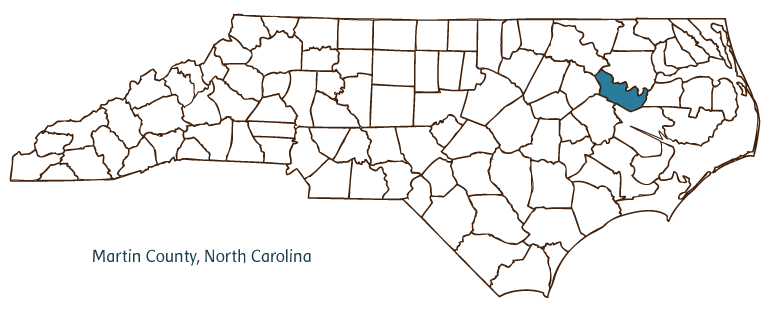Martin County Resources
- View All:
- Biographies
- Monuments
- locations
Technicians will be working on our network from 5 a.m. to 11 a.m. on Saturday, Dec. 13th. We apologize in advance for any downtime you may experience during this time.
Copyright Notice: This article is from the Encyclopedia of North Carolina edited by William S. Powell. Copyright © 2006 by the University of North Carolina Press. Used by permission of the publisher. For personal use and not for further distribution. Please submit permission requests for other use directly to the publisher.

Martin County, located in North Carolina's Coastal Plain region, was formed from Halifax and Tyrrell Counties in 1774. It was named for Josiah Martin, the last royal governor of North Carolina. The county seat of Williamston (originally Squhawky or Skewarky) was incorporated in 1779; other communities include Oak City, Jamesville, Hamilton, Hassell, Gold Point, Parmele, Everetts, Robersonville, Bear Grass, and Darden.
The area that became Martin County was settled by English colonists early in the eighteenth century, supplanting the land's original Tuscarora Indian inhabitants. Williamston, the county's first incorporated town, developed along the banks of the Roanoke River as an important shipping hub for tar, turpentine, and other local products. Although later towns such as Jamesville and Hamilton were established along the river to participate in the thriving shipping business, Williamston continued to flourish as a trade center throughout the nineteenth century and well into the twentieth with its integration into a network of railroads and highways.
The Confederate outpost Fort Branch is one of Martin County's popular tourist attractions, and the Roanoke River and its surrounding lowlands provide an abundance of opportunities for hunting and fishing. Tobacco, peanuts, corn, soybeans, and cotton are produced in Martin County, and its manufactured products include paper, farm machinery, and textiles. In 2004 Martin County's estimated population was 24,700.
For an annotated history of the county's formation, with the laws affecting the county, boundary lines and changes, and other origin information, visit these references in The Formation of the North Carolina Counties (Corbitt, 2000), available online at North Carolina Digital Collections (note, there may be additional items of interest for the county not listed here):
County formation history: https://digital.ncdcr.gov/Documents/Detail/the-formation-of-the-north-ca...
Index entry for the county: https://digital.ncdcr.gov/Documents/Detail/the-formation-of-the-north-ca...
References:
Martin County Heritage (1980).
Additional resources:
Corbitt, David Leroy. 2000. The formation of the North Carolina counties, 1663-1943. https://digital.ncdcr.gov/Documents/Detail/the-formation-of-the-north-carolina-counties-1663-1943/3692099?item=4553233 (accessed June 20, 2017).
Martin County Government: https://www.martincountyncgov.com/
Martin County Chamber of Commerce: http://www.martincountync.com/
Martin County resources, NC Digital Heritage Center: https://www.digitalnc.org/counties/martin-county/
North Carolina Digital Collections (explore by place, time period, format): https://digital.ncdcr.gov
Image credits:
Rudersdorf, Amy. 2010. "NC County Maps." Government & Heritage Library, State Library of North Carolina.
Vocci, Robert Blair. "Martin County." NCpedia. State Library of NC. 2006. https://www.ncpedia.org/geography/martin.